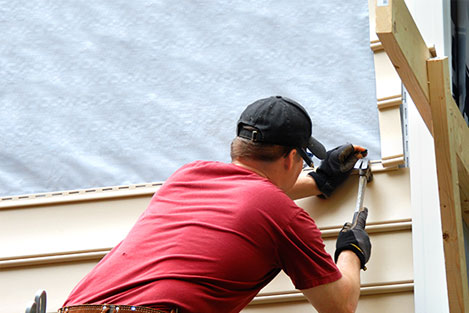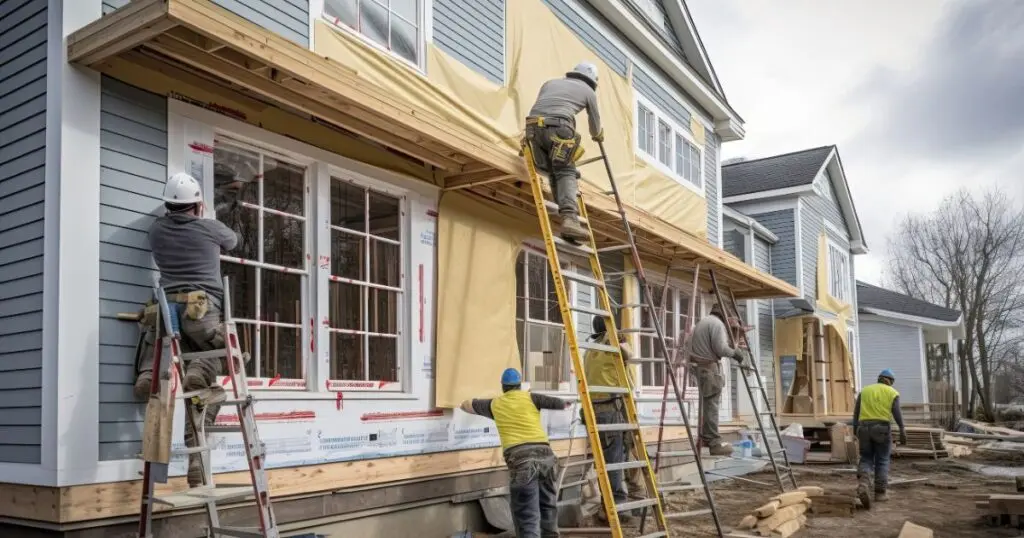The Essential Guide to the Different Sorts Of House Siding and Their Unique Benefits
In the realm of home renovation, picking the appropriate exterior siding is an essential choice that impacts both visual allure and practical efficiency. With so many alternatives to consider, which house siding product absolutely stands out for your details task?
Wood House Siding
Wood house siding, a preferred selection for domestic outsides, offers a classic visual that combines natural elegance with structural integrity. This house siding material is available in various designs, consisting of clapboard, roof shingles, and board-and-batten, allowing house owners to personalize their façade to match their style preferences. Wood home siding is commonly crafted from sturdy species such as cedar, redwood, or pine, which are known for their resilience and capacity to endure ecological stress factors.
One of the key benefits of timber exterior siding is its exceptional insulation residential properties, which can add to power performance and reduced home heating expenses. Furthermore, timber siding is eco-friendly, making it an eco-friendly choice when sourced sustainably. Routine maintenance, consisting of painting or discoloration, can prolong its lifespan and improve its appearance, allowing house owners to protect the natural appeal of the timber.
Nevertheless, potential disadvantages consist of vulnerability to insects, rot, and climate damage, demanding sufficient therapy and maintenance - morris siding contractor. Regardless of these issues, when effectively cared for, timber house siding can supply a sturdy and lovely remedy that enhances the character of a home while offering a warm, inviting environment

Plastic Home Siding
Vinyl siding has arised as a leading selection for property owners looking for a low-maintenance exterior alternative that combines sturdiness and cost. This functional product is crafted from polyvinyl chloride (PVC), making it resistant to various weather conditions, including wetness and UV rays. Therefore, vinyl siding does not warp, rot, or discolor, guaranteeing durable aesthetic charm.
One of the key benefits of plastic home siding is its comprehensive series of designs and shades, allowing home owners to attain the preferred seek their building without the requirement for frequent repainting. Additionally, vinyl exterior siding is simple to mount, which can considerably minimize labor prices throughout construction or improvement projects.
Vinyl home siding additionally contributes to energy efficiency. Many alternatives feature insulation backing, which enhances thermal performance, aiding to keep comfortable interior temperatures and possibly lowering energy expenses. Its smooth surface helps with easy cleansing, requiring just routine washing with a yard pipe to eliminate dirt and debris.
Fiber Cement House Siding
Fiber concrete house siding has acquired traction among property owners and home builders alike due to its exceptional combination of toughness and visual adaptability. Composed of a combination of concrete, sand, and cellulose fibers, this siding option is crafted to withstand extreme climate condition, consisting of high winds, hefty rainfall, and temperature level fluctuations, making it a lasting choice for household outsides.

One of the main advantages of fiber concrete exterior siding is its resistance to bugs, such as termites, and its non-combustible nature, offering boosted fire safety. morris siding contractor. Furthermore, my response it is offered in a wide range of structures, styles, and shades, enabling home owners to accomplish their preferred visual without giving up efficiency
One more advantage is its reduced maintenance demands; fiber cement home siding generally requires painting or discoloration every 5-10 years, which is much less frequent than other products. Its longevity contributes to a lower general expense of possession, as it minimizes the need for frequent fixings or replacements.
Ultimately, fiber concrete home siding stands for a superb financial investment for those seeking a resistant, eye-catching, and flexible exterior alternative, integrating both form and feature to enhance the home's curb allure.
Steel Home Siding
The attraction of metal home siding depends on its durable durability and contemporary visual charm, making it a preferred selection for contemporary architecture. Offered in materials such as light weight aluminum and steel, metal siding supplies a variety of coatings and shades, permitting house owners to attain a personalized appearance that matches their layout vision.

Energy efficiency is one more significant advantage, as lots of steel exterior siding items are developed with insulation options that assist regulate interior temperatures. This can lead to lowered power prices gradually. Additionally, metal home siding is often recyclable, making it an environmentally friendly selection for sustainability-minded homeowners.
The installment procedure for metal home siding can be fairly uncomplicated, resulting in a quicker turn-around time for construction jobs. On the whole, metal exterior siding incorporates functionality and design, making it find a practical option for those seeking a long-lasting and visually enticing exterior coating.
Block and Stone House Siding
Brick and stone siding sticks out as a classic selection that enhances the aesthetic beauty of any home. Recognized for their resilience and low maintenance, these products give a remarkable roi while boosting the residential property's aesthetic allure. Readily available in different shades, textures, and patterns, brick and rock can be tailored to suit diverse architectural designs, from typical to modern.
Among the primary benefits of brick and stone house siding is their energy efficiency. Both materials have all-natural protecting homes that aid control interior temperatures, possibly reducing heating and air conditioning costs. In addition, they provide premium fire resistance contrasted to other exterior siding choices, adding to improved safety.
Another benefit is their long life. Block and rock can last for years, commonly requiring marginal maintenance past periodic cleansing. Unlike timber exterior siding, they are unsusceptible bugs and rot, ensuring a durable outside that holds up against the aspects.
Conclusion
In summary, the selection of home siding dramatically affects a home's aesthetic appeal, energy effectiveness, and upkeep requirements. Each type of house siding-- whether timber, vinyl, fiber metal, cement, or block and rock-- provides special benefits customized to numerous homeowner preferences and ecological problems.
One of the main benefits of timber home siding is its outstanding insulation this page residential or commercial properties, which can add to power effectiveness and reduced heating prices. Furthermore, wood exterior siding is biodegradable, making it an ecologically friendly alternative when sourced sustainably.One of the main advantages of metal house siding is its resistance to different ecological elements.Power performance is one more substantial benefit, as many steel house siding products are made with insulation options that aid control indoor temperature levels. Each kind of house siding-- whether wood, plastic, fiber concrete, steel, or brick and stone-- supplies distinct advantages customized to numerous homeowner choices and ecological problems.